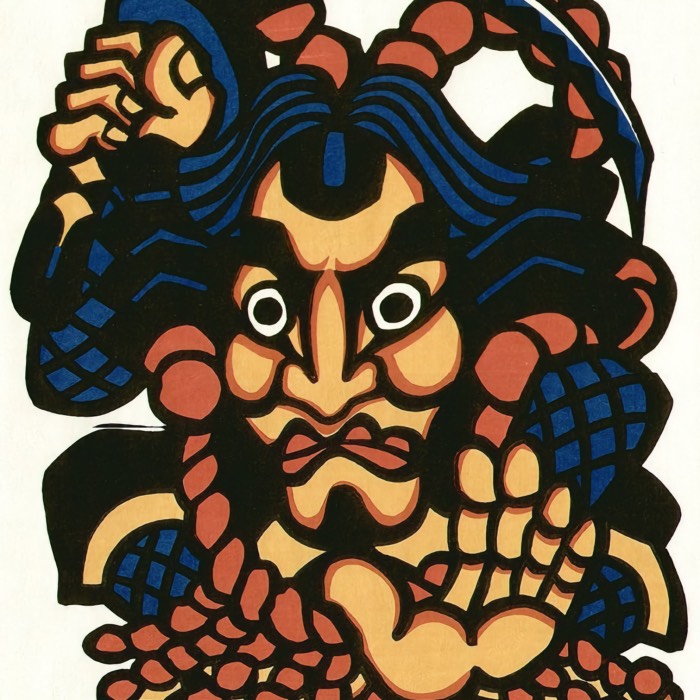Yamamura Kōka: Fusion of tradition and modernity in Shin Hanga
Yamamura Kōka (1885–1942) was another prominent figure in the Shin Hanga movement, known for his striking yakusha-e (portraits of kabuki actors) and bijin-ga (pictures of beautiful women). His work is characterized by a unique blend of traditional Japanese aesthetics and modern artistic influences, making him one of the key artists of his time.
 Jean Valjean of the XIII Morita Kanya, Yamamura Koka, 1921. Source: Wikimedia Commonsꜛ (license: public domain)
Jean Valjean of the XIII Morita Kanya, Yamamura Koka, 1921. Source: Wikimedia Commonsꜛ (license: public domain)
Biography
Yamamura Kōka (山村 耕花), also known as Yamamura Toyonari, was born on November 15, 1885, in Tokyo, Japan. He was a prominent figure in the Shin Hanga movement, particularly recognized for his striking yakusha-e (portraits of kabuki actors) and bijin-ga (pictures of beautiful women). Kōka’s work is celebrated for its unique blend of traditional Japanese aesthetics and modern artistic influences, making him one of the key artists of his time.
 Photograph of Yamamura Koka, 1935. Source: Wikimedia Commonsꜛ (license: public domain)
Photograph of Yamamura Koka, 1935. Source: Wikimedia Commonsꜛ (license: public domain)
Kōka showed an early interest in art, and his talent was nurtured from a young age. He studied Nihonga (traditional Japanese painting) under the guidance of well-known teachers and developed a strong foundation in traditional Japanese techniques. His early training provided him with a deep understanding of the aesthetics and principles that would later influence his work in woodblock printing.
In the early 20th century, Kōka became associated with the Shin Hanga movement, which sought to revitalize traditional Japanese woodblock printing by incorporating modern elements and appealing to both Japanese and Western audiences. Kōka’s work was particularly admired for its bold use of color, dynamic compositions, and the way it captured the spirit of the modern age while remaining deeply rooted in Japanese tradition.
Kōka’s collaboration with the renowned publisher Watanabe Shōzaburō was instrumental in bringing his work to a wider audience. His prints of kabuki actors were especially popular and are considered some of the finest examples of yakusha-e in the Shin Hanga movement.
Yamamura Kōka continued to produce art until his death in 1942. His legacy as a master of yakusha-e and bijin-ga remains influential, and his work is highly regarded by collectors and art historians alike.
Artistic style and significance
Yamamura Kōka is best known for his yakusha-e and bijin-ga prints, which are characterized by their dynamic compositions, bold use of color, and the ability to capture the essence of his subjects. His work reflects a deep respect for traditional Japanese art forms while also embracing the modern influences that were shaping Japan during the early 20th century.
Yakusha-e: Capturing the drama of kabuki theater
Kōka’s yakusha-e prints are celebrated for their ability to convey the intensity and emotion of kabuki performances. He had a remarkable talent for capturing the larger-than-life personalities of kabuki actors, often depicting them in their most famous roles with exaggerated expressions and dramatic poses that reflect the stylized nature of kabuki theater.

Jean Valjean of the XIII Morita Kanya, Yamamura Koka, 1921. Source: Wikimedia Commonsꜛ (license: public domain)
One of the defining features of Kōka’s yakusha-e is his use of bold, vibrant colors, which adds to the theatricality of the prints. He paid meticulous attention to the details of the actors’ costumes, makeup, and hairstyles, creating portraits that are both visually striking and faithful to the traditions of kabuki.
Kōka’s ability to depict the emotional depth and complexity of kabuki characters made his prints highly popular among both Japanese and Western audiences. His work played a significant role in promoting kabuki theater and preserving its visual legacy during a time of rapid cultural change in Japan.
Bijin-ga: The graceful elegance of modern women
In addition to his yakusha-e, Kōka also created bijin-ga prints that depict women with a sense of elegance and poise. His bijin-ga are noted for their refined beauty and the way they reflect the changing roles of women in Japanese society during the early 20th century.

Maiko, Yamamura Kōka, 1924. Source: ukiyo-e.orgꜛ
Kōka’s bijin-ga often feature women in traditional attire, engaged in everyday activities or moments of quiet reflection. His use of soft lines and delicate colors creates a sense of grace and serenity, while his attention to detail in the rendering of clothing and accessories highlights his skill as a draftsman.
Kōka’s bijin-ga are not merely idealized portraits of beauty; they also capture the individuality and inner world of the women he depicted. His prints reflect a modern sensibility, portraying women who are both connected to tradition and engaged with the evolving cultural landscape of their time.
Fusion of tradition and modernity
Kōka’s work is characterized by a successful fusion of traditional Japanese aesthetics and modern artistic influences. His training in Nihonga provided him with a strong foundation in the principles of Japanese art, while his exposure to Western art and modern trends allowed him to experiment with new techniques and approaches.
This blend of old and new is evident in Kōka’s use of color, composition, and subject matter. His prints often feature bold, dynamic compositions that draw the viewer’s eye and create a sense of movement and energy. At the same time, his adherence to traditional techniques, such as the careful rendering of details and the use of flat planes of color, ensures that his work remains rooted in the Japanese artistic tradition.
Kōka’s ability to balance tradition and modernity made his work highly relevant to his contemporaries and has ensured its continued appeal to later generations. His prints are considered some of the finest examples of the Shin Hanga movement’s ability to revitalize traditional art forms while also embracing the changes of the modern world.
Impact and legacy
Yamamura Kōka’s contribution to the Shin Hanga movement is significant, particularly in the genres of yakusha-e and bijin-ga. His work helped to promote and preserve the visual culture of kabuki theater during a period of great change in Japan, and his portraits of women reflect the evolving roles and identities of Japanese women in the early 20th century.
Kōka’s prints continue to be highly valued by collectors and art enthusiasts, both for their artistic quality and for their historical significance. His ability to capture the spirit of his subjects, whether in the dramatic intensity of kabuki actors or the quiet elegance of modern women, has earned him a lasting place in the history of Japanese art.
Notable works
Throughout his career, Yamamura Kōka produced several notable prints that are considered masterpieces of the Shin Hanga movement. Here are some of his most famous works:


Left: Dancing at the New Carlton Hotel in Shanghai, Yamamura Koka, 1924. Source: Wikimedia Commonsꜛ (license: public domain) – Right: Portrait of Nakamura Kichisaemon I as Hoshikage Doemon in the scene Gojō-zaka Nakanochō of the play Soga moyō tateshi no gosho-zome, Yamamura Koka. Source: Wikimedia Commonsꜛ (license: public domain)


Left: Ichikawa Shocho II as Oman, Yamamura Kōka, 1922. Source: ukiyo-e.orgꜛ – Right: The Actor Sawamura Sonosuke in the Female Role of Umegawa, Yamamura Kōka, 1922. Source: ukiyo-e.orgꜛ


Left: Rafu, Yamamura Kōka, 1931. Source: ukiyo-e.orgꜛ – Right: February - Wintry Sky, Yamamura Kōka, 1924. Source: ukiyo-e.orgꜛ
 View of Fuji from Izumo, Yamamura Kōka, 1924.jpg. Source: ukiyo-e.orgꜛ
View of Fuji from Izumo, Yamamura Kōka, 1924.jpg. Source: ukiyo-e.orgꜛ
 Zinnias in Vase, Yamamura Kōka. Source: ukiyo-e.orgꜛ
Zinnias in Vase, Yamamura Kōka. Source: ukiyo-e.orgꜛ
Conclusion
Yamamura Kōka is remembered as one of the most significant artists of the Shin Hanga movement, particularly for his contributions to the genres of yakusha-e and bijin-ga. His prints, characterized by their dynamic compositions, bold use of color, and ability to capture the essence of his subjects, continue to be celebrated for their artistic quality and historical significance. Kōka’s work remains highly valued by collectors and art enthusiasts, ensuring his lasting place in the history of Japanese art.
References and further reading
- Chris Uhlenbeck, Jim Dwinger, Philo Ouweleen, Shin Hanga - Die »Neuen Drucke« Japans 1900-1950, 2022, Hatje Cantz, ISBN: 9783775752190
- viewingjapaneseprints.netꜛ
- Yamamura Kōka on ukioy-e.orgꜛ










comments